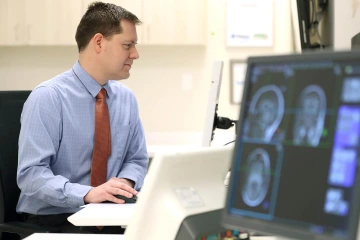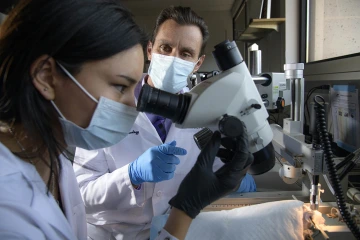New Partnership Set to Transform Pain and Addiction Research
Researchers at two state universities are joining forces to battle the opioid epidemic with help from decades of chemistry research conducted by Purdue Pharma.

Fentanyl, the drug currently driving the opioid epidemic, is an extremely powerful narcotic that can be lethal even in small amounts. A new partnership is focusing on combating the opioid crisis, ameliorating the suffering of chronic pain while decreasing
Long before the first synthetic drug, chloral hydrate, was discovered in 1869, people treated various ailments with medications from natural sources including herbs and plants such as Papaver somniferum, the opium poppy, and Cannabis sativa. Many pain relief medications including opioids and aspirin, one of the most commonly used drugs in the world, represent synthetic or semi-synthetic versions of plant extracts that were developed, tested and optimized by scientists in a laboratory.
Opioids remain the standard by which medications to treat acute pain are measured, but they are a leading cause of epidemic levels of substance abuse and death from overdose. They also are not recommended for the treatment of chronic non-cancer pain, leaving an unmet medical need to be filled.

From left: Frank Porreca, PhD, Don Kyle, PhD, and Todd Vanderah, PhD, are heading up a new partnership between the University of Arizona Health Sciences and the Oklahoma State University Center for Health Sciences.
Researchers at the University of Arizona Health Sciences and the Oklahoma State University Center for Health Sciences recently created an innovative partnership to combat the opioid crisis and to discover and develop modern therapeutics for the treatment of chronic pain.
“Through research, treatment and education, this partnership will accelerate our ability to discover novel medications, devices and therapies to help those who suffer from opioid use disorder and chronic pain,” said Todd Vanderah, PhD, director of the UArizona Health Sciences Comprehensive Center for Pain and Addiction, professor and chair of the Department of Pharmacology in the UArizona College of Medicine – Tucson and BIO5 Institute member. “This relationship will leverage each institution’s research strengths, their dedication to clinical care and their passion to make a change.”
The quest to build a better opioid
The opium poppy was used for pain relief as early as 3,400 B.C., but it wasn’t until around 1804 that scientists examining the plant were able to isolate morphine, a powerful pain-killing narcotic that is the basis for most other opiates including heroin. In 1916, oxycodone, a semi-synthetic opioid, was synthesized as a safer alternative to heroin, opium and morphine.
“People have been working on synthetic changes to the opioid structures for more than 100 years,” said Don Kyle, PhD, CEO of the National Center for Wellness and Recovery at Oklahoma State University’s Center for Health Sciences. “The goal has always been to try to find a structure that would produce the desired pharmacology but take away the side effects, especially the respiratory depression and addictive properties.”

Oxycontin was formulated as an extended-release pill, which was intended to reduce the potential for abuse. But ingesting or injecting a crushed pill provided an immediate high dose of oxycodone, which contributed to the misuse and abuse of the powerful opioid.
In the quest to develop a modern drug for pain relief, pharmaceutical company Purdue Pharma designed an extended-release formulation of oxycodone called OxyContin in 1996. It became one of the most widely prescribed drugs for pain, but millions of people misused and abused the drug, resulting in a swell of overdose-related deaths. Today, fentanyl, a synthetic opioid 100 times more powerful than morphine and developed in 1959, is responsible for the majority of overdose deaths.
“We don’t have appropriate opioid antagonists that are sufficiently capable of dealing with overdoses of fentanyl,” said Frank Porreca, PhD, a world-renowned pain researcher, associate research director of the Comprehensive Center for Pain and Addictionand principal investigator of the National Institute on Drug Abuse-funded “Center of Excellence for Addiction Studies” grant. “We have Naloxone, which is effective, but it is not potent enough and it is not long-lasting enough. We need better medications to deal with fentanyl overdose.”
The answer to that problem and other similar challenges might be found in the unlikeliest of places – a treasure trove of more than 18,000 novel molecules representing decades of research conducted by scientists at Purdue Pharma, which ended its drug research program in 2015.

The National Center for Wellness and Recovery is Oklahoma’s most comprehensive research center for treating pain and addiction. A settlement between the State of Oklahoma and Purdue Pharma in March 2019, established a nearly $200 million endowment for the center, which later received access to approximately 18,000 research molecules that were developed to treat pain and addiction along with nearly 50,000 human bio-samples from consenting patients enrolled in more than 20 phase 2 and 3 clinical trials.
“In my role prior to joining OSU, we studied the 100 prior years of opioid-related chemistry literature, and we learned from that,” said Dr. Kyle, a chemist and former vice president of discovery for Purdue Pharma. “We combined that with state-of-the-art pharmacological techniques and instrumentation, with an eye toward emerging mechanisms that held promise for separating opioid-strength pain relief from unwanted opioid effects. Ultimately, we designed new molecules that might at least serve as research tools but that might also become new drug candidates, and therefore would be valuable to advance the science of pain and addiction.”
The research – and the molecules – sat untouched until 2019, when Dr. Kyle suggested the molecules be made available to OSU’s National Center for Wellness and Recovery, which had just received $200 million from a lawsuit the state of Oklahoma filed against Purdue Pharma.
“Many of the molecules are very raw chemical structures that have never been tested but are molecules we know will bind to one of the opiate receptors,” Dr. Vanderah said. “There are other types of novel opiate-like chemicals that may not be rewarding, reducing the likelihood of addiction that have never been tested, as well different categories of non-opioid molecules that were designed to attenuate pain.”
Working together to advance solutions for pain and addiction
“There is an undeniable link between opioids and pain, and the other crisis that exists in the United States is the pain crisis,” Dr. Porreca said. “In America, more people live with chronic pain than with cancer, heart disease and diabetes combined. We don’t have medications for the treatment of this type of pain, which underscores the fact that we need to discover something that can help people who live with chronic pain.”
Drug discovery can be described as part chemistry and part biology. Scientists identify the physiological mechanisms that result in pain or addiction and look for ways to manipulate those processes. Chemists systematically change chemical structures to target the mechanisms known to cause pain or addiction, but also to optimize their safety, side effect profile, duration of action, and other properties that are critical to new drug development.

UArizona Health Sciences is uniquely qualified to lead research efforts due to decades of experience studying pain. Comprehensive Pain and Addiction Center leaders say there is an undeniable link between opioids and their ability to modulate pain, but also their negative side effects including addiction.
“The partnership between chemistry and biology is absolutely crucial to a successful breakthrough in the areas of pain and addiction,” Dr. Kyle said. “If you're going to translate the discoveries made in biology into human clinical practice, it is most likely going to require designing a molecule of some sort that becomes a therapeutic alternative for what physicians use today.”
The synergistic nature of the research required is perfectly modeled in the partnership between UArizona Health Sciences and OSU’s Center for Health Sciences.
The Comprehensive Center for Pain and Addiction, a strategic initiative at UArizona Health Sciences, is composed of a group of leading scientists with expertise in the overlapping neurobiology of chronic pain and addiction whose work will be strengthened by the availability of novel chemical matter from OSU.
The Center of Excellence for Addiction Studies at UArizona Health Sciences will provide expertise in genetic targeting, the use of neuroanalytical methods, large data analysis and advanced behavioral assessment of drug-like substances, providing critical data that may lead to clinical trials.
In addition to the molecules designed to target neuronal mechanisms associated with chronic pain and addiction, the National Center for Wellness and Recovery has access to 40,000 to 50,000 human biosamples from consenting patients enrolled in more than 20 Phase 2 and 3 clinical trials involving opioids and non-opioids. Recently, the National Center for Wellness and Recovery began collecting additional biosamples from patients suffering from addiction or who are in recovery and undergoing treatment at National Center for Wellness and Recovery treatment centers in Oklahoma.
These unique assets, collected over more than two decades, enable research into risk factors, causes and potential treatments for addiction and chronic pain.
“One of the beautiful things about our partnership is that even without knowing what researchers like Dr. Porecca and Dr. Vanderah were studying, we already made molecules that bind to the various targets they're interested in,” Dr. Kyle said. “We’re very excited to test those molecules and see if we can confirm what they suspect from their biology work using a molecule.”
The goals of the three research centers are aligned with the National Institute on Drug Abuse and the National Institutes of Health’s Helping to End Addiction Long-term initiative, known as the HEAL Initiative. They are focused on combating the opioid crisis, ameliorating the suffering of chronic pain while decreasing opioid use, finding alternatives to opioids for treating acute and chronic pain, promoting recovery and prevention of relapse from opioid use disorder, as well as development of rapidly acting medications for opioid overdose through advancement of novel chemistry, biology, therapies, clinical trials and education.
“This partnership will allow us to combine our resources, expertise and access to novel research assets, including the new molecules, to be able to find new medications for people with chronic pain that do not produce substance use disorder, do not act like narcotics and do not produce opiate addiction,” Dr. Vanderah said. “Our research shows there's a huge overlap of the neuronal networks that are occurring within the human brain with chronic use of opiates without pain and people who have pain. Now we have a whole library of molecules to test that were developed for pain but may also work for people with substance use disorder.”

